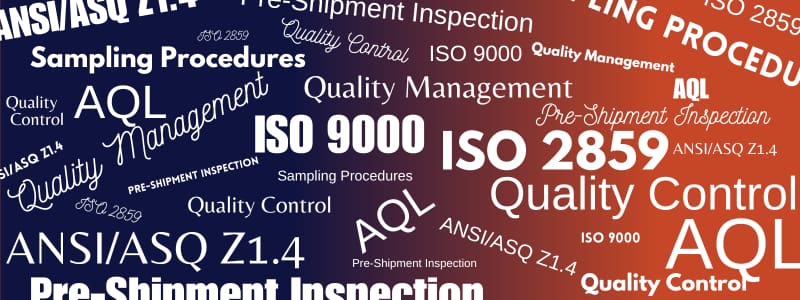| Section | Summary |
|---|---|
| Introduction to Quality Control Inspection | An in-depth introduction to Quality Control Inspection, covering its definition, significance, and scope. |
| The Purpose and Objectives of Quality Control Inspection | Exploring the aims and goals of Quality Control Inspection in maintaining product quality and compliance. |
| Types of Quality Control Inspections | A detailed look at the various types of Quality Control Inspections, from FAI to Pre-Shipment Inspection. |
| Quality Control Standards | Overview of the key standards guiding Quality Control and Pre-Shipment Inspections, including ISO and AQL. |
| Challenges in Quality Control Inspection | Addressing the common challenges faced in Quality Control Inspection processes. |
| Conclusion: The Crucial Role of Quality Control Inspection | Summarizing the importance and impact of Quality Control Inspection in various industries. |
I. Introduction to Quality Control Inspection
Quality Control Inspection is about maintaining standards and product quality. It’s a systematic process where professionals scrutinize various aspects of a product or service to ensure they meet specific criteria. These criteria could range from safety standards, functionality, to customer satisfaction. The goal of quality inspections? To deliver a product or service that not only meets but often exceeds customer expectations.
A. How Does Quality Control Inspection Work?
QCI works in stages. First, there’s the planning phase where quality parameters are defined. These are the benchmarks that products or services must meet. Then comes the execution phase. Here, quality inspectors get down to the nitty-gritty. They examine materials, processes, and finished products using a range of techniques from visual inspections to complex testing methods.
The process is rigorous. Quality control Inspectors might use statistical sampling – where they test just a part of a batch to draw conclusions about the whole. Or, they may go for 100% inspection, scrutinizing every single unit. Whatever the method, the aim is to identify defects or deviations from the set standards.
The Role of Quality Control Inspectors
Quality Control Inspectors are the champions of this process. They’re trained to spot issues that might escape an untrained eye. They use specialized equipment, like calipers, gauges, and even computerized testing systems, to measure and test products. Their keen observation and analytical skills ensure that only the best-quality products make it to the market.
Why is Quality Control Inspection Crucial?
The benefits of QCI are manifold. For businesses, it’s a way to maintain reputation and customer trust. A single faulty product can tarnish a brand’s image, but regular inspections minimize this risk. For customers, QCI is a reassurance that what they’re buying is safe and worth their money. In industries like pharmaceuticals or automotive, where safety is paramount, QCI is non-negotiable.
B. Quality Control Inspection Definitions
Definition 1
Quality Control as defined by ASQ (American Society for Quality): It is a part of quality management that focuses on fulfilling quality requirements. This aspect of quality management primarily deals with the inspection side of the process, involving operational techniques and activities used to meet the quality standards.
Definition 2
“Quality Control Inspection is the systematic process of checking products to ensure they meet specified standards of quality and compliance. It is a vital part of the manufacturing process that involves evaluating and testing products for defects, non-conformities, and overall performance.”
Definition 3
“Quality Control Inspection refers to the detailed examination of goods or services against predefined quality criteria. It encompasses various techniques and procedures aimed at identifying and correcting issues before the product reaches the final customer, thereby ensuring customer satisfaction and adherence to industry standards.”
In the following sections, we will uncover the nuances of this process, its methodologies, the challenges faced, and the standards that guide it.
II. The Purpose and Objectives of Quality Control Inspection
A. Ensure Product Quality and Consistency
The primary objective of Quality Control Inspection is to ensure product quality and consistency. This aspect is crucial in today’s market, where the slightest deviation in quality can lead to customer dissatisfaction and, subsequently, a tarnished brand reputation. QCI acts as a bulwark, ensuring that every product aligns with the specifications and expectations set forth at the onset. It is not just about catching defects; it is about creating a culture of excellence where the highest standards are the norm.
B. Compliance with Standards and Regulations
Another essential objective is compliance with industry standards and regulations. Various industries are governed by specific standards and legal requirements, often designed to ensure safety, reliability, and efficiency. QCI ensure that products are not just appealing but are also safe, reliable, and compliant with these regulatory frameworks. This compliance is not just a legal obligation; it is a moral one, ensuring that the products contribute positively to the lives of the consumers and the environment.
C. Compliance with Standards and Regulations
QCI serve as an early warning system, identifying potential issues before they escalate into major problems. This proactive approach not only saves time and resources but also reinforces the commitment to quality and customer satisfaction.
D. Process Improvement
By consistently monitoring and evaluating products and processes, quality inspections provides valuable insights into areas that require refinement. This continuous feedback loop is instrumental in driving innovation and efficiency, leading to improved processes, reduced waste, and enhanced product quality.
E. Supplier Quality Management
Quality Inspection also extends its reach to supplier quality management. In the globalized supply chain, the quality of raw materials and components significantly impacts the final product’s quality. Through rigorous inspection processes, businesses can ensure that their suppliers adhere to the same high standards of quality, creating a unified front in the pursuit of excellence.
III. Types of Quality Control Inspections

The term ‘Quality Control Inspection’ is not a one-size-fits-all concept. Rather, it unfolds into a spectrum of diverse types, each tailored to specific stages of a product’s lifecycle. Understanding these various types of QCI is crucial for anyone involved in the production process, from designers and engineers to quality assurance professionals.
A. Initial Production Check (IPC)
Conducted at the very beginning of production, Initial Production Check is the critical first step in ensuring that the manufacturing process can produce an item that meets design specifications and requirements. It involves a comprehensive and detailed examination of the first sample produced, serving as a prototype for subsequent production. The objective here is to verify that the production methods, materials, and tooling can deliver a product that matches the blueprint, both in terms of quality and functionality.
B. During Production Inspection (DUPRO)
As the name suggests, this inspection occurs throughout the production process. It’s a proactive approach, aiming to identify and rectify defects or deviations from quality standards as they happen. DUPRO are systematic and continuous, often employing statistical methods to monitor quality. They play a key role in ensuring that each step of the manufacturing process aligns with the set standards, thereby maintaining a consistent quality level throughout production.
C. Pre-Shipment Inspection (PSI)
Another critical type, comes into play in the final phase before the products are dispatched to customers or retailers. This type of inspection is particularly significant in international trade, where the buyer might not have the opportunity to inspect the goods before receiving them. Pre-Shipment Inspections are thorough examinations of product quantity, quality, packaging, and labeling. They ensure that the products being shipped are in accordance with the purchase order specifications and are packed and labeled correctly, ready for safe transportation to their final destination.
Each of these inspection types is a cog in the quality control machine, functioning to ensure that every aspect of a product, from its inception to its arrival in the customer’s hands, is subjected to rigorous and systematic scrutiny. They are not isolated processes but are interconnected, creating a comprehensive and dynamic quality control system that underpins the manufacturing process.
IV. Quality Control Inspection Standards

Standards and certifications are not just formalities; they are the backbone of a robust quality management system. These standards serve as the guiding principles and benchmarks that shape the practices and processes of quality control. Understanding these standards and the certification processes associated with them is pivotal for any business striving for excellence in product quality and reliability.
A. ISO 2859 – Sampling Procedures for Inspection by Attributes
A cornerstone in the realm of Quality Control Inspections, ISO 2859 is pivotal for its role in providing sampling procedures. This standard outlines methods for inspecting a sample batch of products to determine if the entire batch meets the specified quality criteria. It’s particularly relevant in situations where inspecting every single item is not feasible due to time or cost constraints. ISO 2859 helps in determining the sample size, inspection levels, and acceptable quality levels (AQLs) – crucial factors in deciding whether a batch passes or fails the inspection.
B. ANSI/ASQ Z1.4 – Sampling Procedures and Tables for Inspection
Similar to ISO 2859, the ANSI/ASQ Z1.4 standard is widely used for determining sample sizes and setting quality levels. This standard is essential for Quality Control Inspectors in deciding the number of units to inspect from a large batch and in assessing the maximum number of defects acceptable. It plays a significant role in ensuring that the inspection process is both efficient and effective.
C. ISO 9000 Series – Quality Management Principles
While ISO 9000 is typically associated with Quality Management, its principles are directly applicable to Quality Control Inspections. This series provides a set of standards that help organizations ensure they meet customer and other stakeholder needs within statutory and regulatory requirements related to a product or service. Although not specifically a Quality Control standard, ISO 9000 provides the foundational principles that guide the overall quality ethos, influencing the approach and methodology of quality control inspections.
D. AQL (Acceptable Quality Limit) Standards
AQL Standards are critical in Pre-Shipment Inspections. They define the quality threshold level that is considered acceptable. In simple terms, AQL is the maximum number of defective items that could be considered acceptable during the random sampling of an inspection. These standards are vital in decision-making processes during pre-shipment inspections, aiding inspectors in determining whether a product batch should be accepted or rejected.
V. Challenges in Quality Control Inspection
The challenges are as diverse and complex as the processes and products they aim to perfect. For professionals in this field, understanding and overcoming these hurdles is not just part of the job; it’s essential for ensuring the consistent delivery of high-quality products.
A. Product designs and materials
As technology advances, products become more complex, integrating new materials and sophisticated components. This evolution demands Quality Control Inspections to be continuously updated and refined. Inspectors must stay abreast of these changes, adapting their techniques and tools to effectively evaluate new products. This requires ongoing training and development, ensuring that the inspection team is always equipped with the latest knowledge and skills.
B. Globalization of supply chains
Today’s products often have components sourced from different parts of the world, each with its own set of standards and quality practices. Managing this global supply chain, ensuring consistency and quality across various suppliers, and navigating the logistical complexities present a formidable task. This calls for a robust quality management system that can integrate and standardize inspection practices across diverse geographical locations.
C. Balancing quality with cost and efficiency
QCI, by nature, are detailed and time-consuming. In a market where time is money, striking the right balance between thorough inspections and efficient production is crucial. Companies must invest in efficient quality control processes that do not compromise the thoroughness of inspections. This often requires leveraging advanced technologies and methodologies to streamline inspection processes without diluting their effectiveness.
D. Regulatory changes and standards
Regulations and standards are continually evolving, driven by technological advancements, changing market demands, and emerging safety and environmental concerns. Companies must ensure that their Quality Control Inspections are not just compliant with current regulations but are also forward-thinking, anticipating future changes and trends.
E. Human factors
The reliance on human judgment and skill means that there is always a risk of human error. Training and maintaining a skilled workforce, ensuring consistency in inspections, and managing human factors like fatigue and motivation are ongoing challenges in this field.
VI. Conclusion – Quality Control Inspection
As we draw the curtains on our exploration of Quality Control Inspection, it becomes evident that this process is much more than a mere checkpoint in the production cycle. It is a vital cog in the machinery of manufacturing and service industries, ensuring that the wheels of quality and excellence keep turning smoothly.
QCI stands as a testament to a company’s commitment to excellence. It is a promise of reliability and safety to customers, a pledge that every product that leaves the production line is not just good enough, but the best it can be. Through rigorous inspections, adherence to standards, and overcoming challenges, Quality Inspection plays a pivotal role in building and maintaining the trust that customers place in products and services.
This journey through the various facets of inspections – from its objectives and types to the standards, certification processes, and challenges – reveals its complexity and significance. It’s a process that requires precision, expertise, and an unwavering dedication to quality. It’s a process that, though often behind the scenes, is fundamental in shaping the face of a product and, by extension, the reputation of a company.


